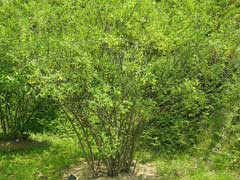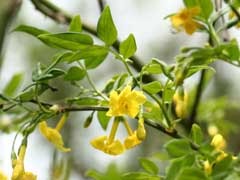 |
|
http://commons.wikimedia.org/wiki/User:KENPEI |
 |
|
Translate this page:
Summary
Physical Characteristics

 Jasminum humile is an evergreen Shrub growing to 3 m (9ft) by 3 m (9ft).
Jasminum humile is an evergreen Shrub growing to 3 m (9ft) by 3 m (9ft).
See above for USDA hardiness. It is hardy to UK zone 8. It is in leaf all year, in flower from July to August. The species is hermaphrodite (has both male and female organs) and is pollinated by Insects.
Suitable for: light (sandy), medium (loamy) and heavy (clay) soils and prefers well-drained soil. Suitable pH: mildly acid, neutral and basic (mildly alkaline) soils. It can grow in semi-shade (light woodland) or no shade. It prefers dry or moist soil.
UK Hardiness Map
US Hardiness Map
Synonyms
J. bignoniaceum. Wall.
Plant Habitats
Woodland Garden Sunny Edge; Dappled Shade;
Edible Uses
Edible Parts:
Edible Uses: Condiment Tea
The leaves are used as a condiment[177, 183]. A tea is made from the leaves and bark[183].
References More on Edible Uses
Medicinal Uses
Plants For A Future can not take any responsibility for any adverse effects from the use of plants. Always seek advice from a professional before using a plant medicinally.
Astringent Cardiotonic Decongestant Parasiticide Stomachic Tonic
The flowers are astringent and a tonic for the heart and bowels[240]. A paste made frm the flowers is considered effective in the treatment of intestinal problems[272]. The juice of the root is used in the treatment of ringworm[240, 272]. The milky juice of the plant is used for destroying the unhealthy lining walls of chronic sinuses and fistulas[240].
References More on Medicinal Uses
The Bookshop: Edible Plant Books
Our Latest books on Perennial Plants For Food Forests and Permaculture Gardens in paperback or digital formats.

Edible Tropical Plants
Food Forest Plants for Hotter Conditions: 250+ Plants For Tropical Food Forests & Permaculture Gardens.
More

Edible Temperate Plants
Plants for Your Food Forest: 500 Plants for Temperate Food Forests & Permaculture Gardens.
More

More Books
PFAF have eight books available in paperback and digital formats. Browse the shop for more information.
Shop Now
Other Uses
References More on Other Uses
Cultivation details
Succeeds in a good well-drained loam in a sunny position[1, 200]. Tolerates light shade[202]. Tolerates most soil types, including dry soils once it is established[202]. This species is not very cold hardy, tolerating temperatures down to about -10°c[184]. It requires some protection such as a warm wall when grown outdoors in Britain[200]. There are some named varieties selected for their ornamental value[188]. The flowers are slightly scented[245]. Plants produce suckers and these can sometimes be invasive[202]. Pruning can be carried out in early to mid spring. Removing one third of the oldest growth down to ground level rejuvenates the plant and encourages greater flowering[202]. Plants in this genus are notably resistant to honey fungus[200].
References Carbon Farming Information and Carbon Sequestration Information
Temperature Converter
Type a value in the Celsius field to convert the value to Fahrenheit:
Fahrenheit:
The PFAF Bookshop
Plants For A Future have a number of books available in paperback and digital form. Book titles include Edible Plants, Edible Perennials, Edible Trees,Edible Shrubs, Woodland Gardening, and Temperate Food Forest Plants. Our new book is Food Forest Plants For Hotter Conditions (Tropical and Sub-Tropical).
Shop Now
Plant Propagation
Seed - best sown as soon as it is ripe in a cold frame. When they are large enough to handle, prick the seedlings out into individual pots and grow them on in the greenhouse for at least their first winter. Plant them out into their permanent positions in late spring or early summer, after the last expected frosts. Cuttings of half-ripe wood, July/August in a frame. Very easy. Cuttings of mature wood in November. Layering.
Other Names
If available other names are mentioned here
Native Range
TEMPERATE ASIA: Afghanistan, Tajikistan, China (Gansu Sheng, Guizhou Sheng (west), Sichuan Sheng (southwest), Xizang Zizhiqu, Yunnan Sheng) TROPICAL ASIA: Bhutan, India (north), Nepal, Pakista
Weed Potential
Right plant wrong place. We are currently updating this section.
Please note that a plant may be invasive in one area but may not in your area so it's worth checking.
Conservation Status
IUCN Red List of Threatened Plants Status :

Growth: S = slow M = medium F = fast. Soil: L = light (sandy) M = medium H = heavy (clay). pH: A = acid N = neutral B = basic (alkaline). Shade: F = full shade S = semi-shade N = no shade. Moisture: D = dry M = Moist We = wet Wa = water.
Now available:
Food Forest Plants for Mediterranean Conditions
350+ Perennial Plants For Mediterranean and Drier Food Forests and Permaculture Gardens.
[Paperback and eBook]
This is the third in Plants For A Future's series of plant guides for food forests tailored to
specific climate zones. Following volumes on temperate and tropical ecosystems, this book focuses
on species suited to Mediterranean conditions—regions with hot, dry summers and cool, wet winters,
often facing the added challenge of climate change.
Read More
Expert comment
Author
L.
Botanical References
11145200
Links / References
For a list of references used on this page please go here
Readers comment
© 2010, Plants For A Future. Plants For A Future is a charitable company limited by guarantee, registered in England and Wales. Charity No. 1057719, Company No. 3204567.